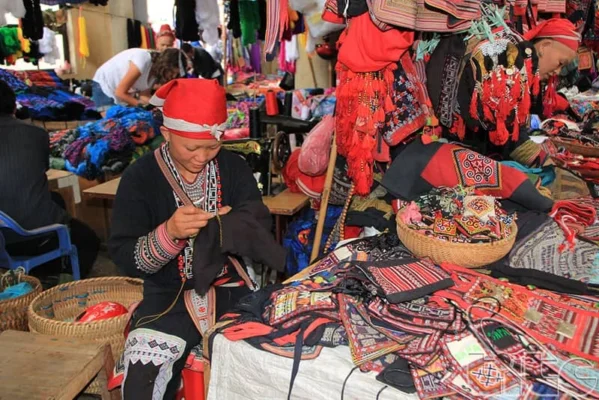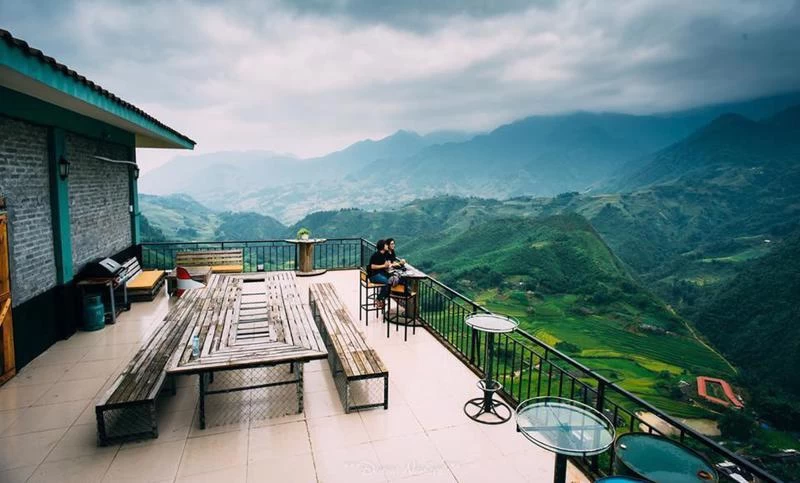
Let’s visit the most beautiful village in Sapa
Discover Cat Cat Village, a picturesque ethnic H’Mong village in Sapa, Vietnam. Explore traditional culture, stunning landscapes, and local craftsmanship. It’s perfect for travelers seeking authentic experiences and breathtaking scenery. Enjoy activities like hiking to the Tien Sa Waterfall, engaging with local artisans, and savoring traditional cuisine. Plan your visit with Ula Travel now to immerse yourself in the beauty and heritage of this unique destination.
I. Introduction to Cat Cat Village
1. Where is Cat Cat Village?

Cat Cat village is located near the center of Sapa town.
Cat Cat Village is a charming and historically significant destination nestled in the heart of the Hoang Lien Son mountain range. Situated within San Sa Ho Commune, Sapa District, Lao Cai Province, the village is just about 2 kilometers from Sapa Town, making it an easily accessible spot for visitors.
Cat Cat Village lies at the foot of the majestic Hoang Lien Son Mountains, surrounded by lush green valleys, terraced rice fields, and winding streams. The village’s location offers breathtaking panoramic views and a peaceful retreat from the hustle and bustle of city life.
Read more: Hanoi to Sapa
2. Highlights of Cat Cat Village

Cat Cat village is home to the H’Mong ethnic group.
Cat Cat Village is one of the oldest ethnic H’Mong villages in Vietnam, established in the 19th century. It is renowned for preserving the unique culture and traditional practices of the H’Mong people. The village is famous for its stunning natural landscapes, vibrant local life, and rich cultural heritage. Visitors come to Cat Cat not only to admire its beauty but also to experience the deep connection between the local community and their ancestral traditions.
Cat Cat Village stands out as a living museum where the traditional customs, attire, and crafts of the H’Mong ethnic group are still preserved. The village offers a unique glimpse into the lifestyle, history, and artistry of one of Vietnam’s most fascinating ethnic minorities, making it a must-visit destination for anyone exploring the Sapa region.
II. Culture of Cat Cat Village
1. Cultural Life
The daily life in Cat Cat Village revolves around the customs and traditions of the H’Mong people. Visitors can explore the rich cultural practices that have been passed down through generations, including traditional clothing, music, and dances. The villagers are known for their hospitality, allowing tourists to immerse themselves in local customs, from observing agricultural practices to participating in community gatherings.
2. Traditional Handicrafts

Tourists visit traditional embroidery village
Cat Cat Village is renowned for its artisanal crafts, which include intricate brocade weaving, silver jewelry making, and traditional paper crafting. The handwoven textiles are particularly famous, with vibrant colors and patterns that reflect the cultural heritage of the H’Mong people.
Visitors can witness the entire process, from spinning and dyeing to weaving, and even purchase these unique handicrafts as souvenirs. The skillful production of silver jewelry and handcrafted paper also highlights the artistic talents of the local community, preserving these age-old crafts for future generations.
III. Must-Visit Attractions at Cat Cat Village
1. Stone-Paved Pathway Leading into the Village

Stone paths leading into the village
One of the most captivating features of Cat Cat Village is its enchanting stone-paved pathway that leads visitors into the heart of the village. This charming walkway is not just a practical route but an integral part of the village’s aesthetic appeal.
- Construction and Design: The pathway is meticulously paved with smooth, flat stones, blending seamlessly with the natural landscape. The stones are carefully arranged to create a sturdy and even surface, making it easier for visitors to navigate the terrain.
- Scenic Beauty: As visitors walk along the pathway, they are greeted by breathtaking views of lush terraced fields, cascading streams, and the traditional wooden houses of the H’Mong people. The pathway meanders through scenic landscapes, offering picturesque photo opportunities at every turn.
2. Terraced Fields on the Hillsides of Cat Cat Village

Don’t miss the picturesque terraced fields.
Cat Cat Village is renowned for its stunning terraced fields that adorn the hillsides around the village. These terraced fields are not just agricultural marvels but also a feast for the eyes, offering picturesque landscapes that change with the seasons.
The terraced fields of Cat Cat Village create a breathtaking tapestry of green and gold, especially during the rice-growing seasons. These fields are meticulously carved into the hillside, creating a series of steps that cascade down the slopes. The lush greenery of the fields during the growing season contrasts beautifully with the golden hues of the ripe rice, providing a stunning visual experience.
Are you looking for: Sapa Tours
3. Tien Sa Waterfall

Tien Sa Waterfall
One of the most iconic spots in Cat Cat Village is Tien Sa Waterfall, a stunning natural feature that perfectly captures the charm of this picturesque village. Located amidst lush green surroundings, the waterfall is a key highlight for visitors exploring the area.
As you make your way through the traditional pathways of the village, Tien Sa Waterfall reveals itself as a serene cascade surrounded by verdant terraced fields and towering mountains. The sound of water gently rushing over the rocks creates a soothing atmosphere, making it an ideal spot for photography, relaxation, and enjoying the natural beauty of northern Vietnam.
The waterfall is not only a scenic delight but also holds cultural significance for the local H’Mong community. Visitors often find themselves drawn to the traditional dances and music performances held near the waterfall, showcasing the rich heritage of the people who have lived in this region for generations.
Learn more about: Northern Vietnam Wonders
4. Traditional H’Mong Houses

You will enjoy visiting the traditional houses of the H’Mong people.
One of the key highlights of Cat Cat Village is the opportunity to explore the traditional houses of the H’Mong ethnic group. These houses are built in a distinctive architectural style, reflecting the lifestyle and cultural heritage of the H’Mong people.
- Unique Architectural Features: The houses are typically made from wood, with thatched or tiled roofs. The structures are sturdy and often include a main room for daily activities, a kitchen, and a storage area. The main room is usually adorned with family heirlooms, traditional tools, and religious items, giving you a glimpse into the spiritual life of the locals.
- Cultural Insights: Visiting a H’Mong house offers more than just architectural admiration; it’s a chance to observe and learn about the day-to-day lives of the residents. You can see how they cook meals over open fires, craft handmade goods like textiles and tools, and maintain a simple but meaningful way of life. The warm hospitality of the villagers often includes sharing stories about their traditions, customs, and the challenges of living in a mountainous environment.
- Traditional Craftsmanship: Many of these homes also serve as small workshops where you can watch artisans create beautiful, handwoven textiles using traditional methods passed down through generations. This craftsmanship is not only a source of income for the villagers but also an important aspect of preserving their cultural identity.
You will be like: 5 Main Ethnic Minorities in Sapa
5. Traditional H’Mong House

Traditional H’Mong House
The Traditional H’Mong House in Cat Cat Village offers visitors a unique insight into the traditional cultural expressions of the H’Mong people. This space is dedicated to showcasing a variety of handcrafted items and local artistic performances that reflect the rich heritage and creativity of the ethnic community.
- Traditional Handicrafts Display: The exhibition features beautifully woven textiles, hand-dyed with natural colors derived from local plants. Intricate patterns are meticulously crafted on each fabric piece, symbolizing different aspects of H’Mong culture, such as their beliefs, nature, and daily life. The delicate silver jewelry on display, often worn during festivals, also highlights the exquisite craftsmanship passed down through generations.
- Musical Instrument Showcase: The area is also known for displaying traditional musical instruments used in daily life and important ceremonies. Visitors can observe unique instruments such as the H’Mong bamboo flute, the khèn (a type of mouth organ), and the đàn môi (a jew’s harp), which are played during communal events and celebrations. These instruments create melodies that tell stories of love, nature, and the community’s history.
- Workshops and Interactive Sessions: For those interested in more hands-on experiences, the exhibition area sometimes hosts workshops where tourists can try their hand at traditional weaving techniques or learn how to play simple tunes on the khèn. These interactive sessions not only make for memorable experiences but also support the preservation of these age-old traditions.
Learn more about: Things to do in Sapa
IV. Top 5 Things to Do in Cat Cat Village
1. Boat Rowing at Cat Cat Village

Boat Rowing at Cat Cat Village
Cat Cat Village offers visitors an authentic and memorable experience with its serene natural beauty. One of the most enchanting activities available to tourists is boat rowing on the village’s tranquil streams. This unique experience provides a wonderful opportunity to immerse oneself in the peaceful environment and appreciate the stunning surroundings.
Start your journey with: Hanoi to Sapa Private Tour
2. Discovering Traditional Craft Villages

Traditional weaving in Cat Cat village
In addition to developing tourism, Cat Cat Village also focuses on preserving traditional craft villages that are at risk of disappearing over time, such as linen weaving, indigo dyeing, forging agricultural tools, carving silver jewelry, etc.
Through this, you will witness the detailed steps to making an elaborate brocade fabric or a silver necklace worn around the necks of the H’Mong people. The sophisticated products not only demonstrate the talent of the artisans but also convey the traditional culture that has been preserved through many generations.
Try it now: Sapa Tour from Hanoi 7 Days
3. Participating in Traditional Activities

Tourists participate in bamboo dance
Engaging with the local H’Mong community offers a deeper insight into their rich cultural heritage. Visitors have the unique opportunity to participate in traditional activities such as watching dance performances, learning about intricate embroidery techniques, and even trying their hand at weaving colorful textiles. The rhythmic sounds of the “khen” (a traditional bamboo flute) and other ethnic instruments fill the air during these cultural exchanges, making the experience truly immersive.
Click here: Best homestays in Sapa
4. Buy Handmade Souvenirs

Handcrafted souvenirs always attract tourists.
In Cat Cat village, visitors can easily find many brocade stalls along the stone-paved roads, ethnic costume shops, or handmade weaving villages. You can buy these brocade products to keep as souvenirs or bring them back as gifts for family and friends. It could be a colorful shirt, a unique head scarf, a pretty handkerchief, or a durable crossbody bag.
Best Sapa tour: Northern Vietnam Itinerary
5. Tasting Local Specialties

Small restaurant with traditional dishes in Cat Cat
A trip to Cat Cat Village is incomplete without indulging in the authentic flavors of local cuisine. Visitors can savor regional delicacies such as thang co (a traditional H’Mong stew made with horse meat and herbs), corn wine (a potent local drink), and xoi ngu sac (five-color sticky rice). These dishes are not only delicious but also represent the deep-rooted culinary traditions of the ethnic minority communities in the region.
Whether you are trying these dishes for the first time or are familiar with Vietnamese cuisine, the unique flavors and preparation methods in Cat Cat Village will leave a lasting impression.
Do not miss: Sapa cuisine
V. Travel Tips for Visitors
1. How to Get to Cat Cat Village
Cat Cat Village is located just 2 kilometers from Sapa Town, making it easily accessible for visitors. Here are the best ways to reach the village:
- Walking: For those who enjoy a bit of exercise, walking from Sapa Town to Cat Cat Village is a pleasant option. The path is scenic and allows you to immerse yourself in the beautiful surroundings of the region. The walk takes approximately 30 minutes, and you’ll have the chance to enjoy the fresh mountain air and stunning views along the way.
- Motorbike Rental: Renting a motorbike is a convenient choice if you prefer a quicker and more flexible mode of transportation. Many rental shops in Sapa offer motorbikes for hire, and the ride to Cat Cat Village is straightforward and enjoyable. It takes about 10 minutes to reach the village by motorbike.
- Taxi: Taxis are readily available in Sapa and can be hired for a direct trip to Cat Cat Village. This option is ideal for those who prefer a comfortable and hassle-free journey. The taxi ride takes approximately 10 minutes, depending on traffic and road conditions.
- Guided Tours: Several tour operators in Sapa offer guided tours that include transportation to Cat Cat Village. This option provides a comprehensive experience, including a knowledgeable guide who can share insights about the village’s culture and history. Guided tours often include additional stops and activities, making them a great way to explore the area.
2. Ticket Prices and Opening Hours for Cat Cat Village
- Entrance Fee: 150,000 VND/01 adult (children: 80,000 VND/01 child) In addition, there are some self-paid fees, such as renting costumes for taking pictures. You should refer to the listed price list and find a facility that suits you.
- Operating Hours: Cat Cat Village is open daily from 5:00 a.m. to 22:00 p.m. This schedule allows visitors to explore the village throughout the day, enjoying both the morning and evening views of the picturesque landscape. It’s recommended to arrive early to make the most of your visit and experience the village in different light conditions.
3. Best Time to Visit Cat Cat Village
The climate of Cat Cat village is a mix of tropical and temperate, so it always maintains a cool temperature all year round. However, in each different season, you can admire the outstanding features of the ancient village. Specifically:
From April to October: This is when the upstream waterfalls begin to pour water down to the village, creating a fierce flow like a song of the old forest and adding vitality to the growth of grass, trees, flowers, and leaves. In particular, you have the opportunity to participate in many folk festivals of the H’Mong people that take place during this time, such as the Long Tong festival or the Gau Tao festival, and learn more about local customs and practices.
From November to March: This is when the peak tourist season has passed and the cold winter winds blow into the village. Therefore, you can enjoy the fresh air, the quiet mountain scenery, and sometimes see the sea of clouds flowing into every breath or the frost and snow condensing on the porch and tree canopy.
In summary, Cat Cat Village offers an unforgettable experience for international travelers seeking to immerse themselves in the rich cultural tapestry of the H’Mong ethnic group. This picturesque village, with its traditional wooden houses, vibrant markets, and breathtaking natural beauty, provides a unique opportunity to connect with local traditions and customs.
Whether you’re marveling at the cascading waterfalls, exploring the intricately crafted handicrafts, or simply enjoying the serene surroundings, Cat Cat Village is a destination that captures the essence of Vietnam’s cultural heritage. For those planning a trip, visiting Cat Cat Village promises an enriching adventure that blends natural splendor with cultural immersion, making it a must-see on your journey through Sapa.
See more: Sapa travel tips



























